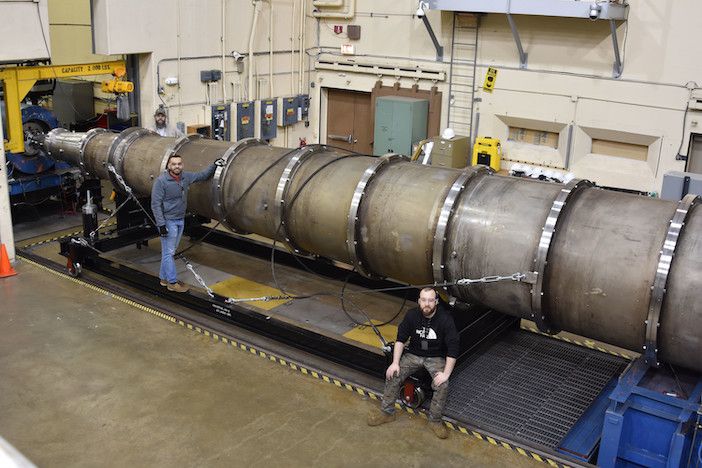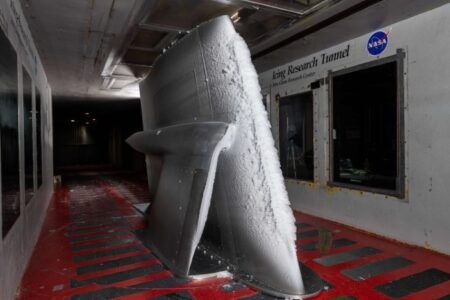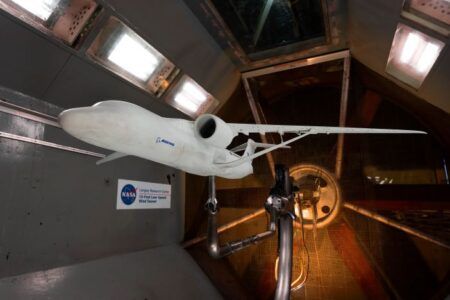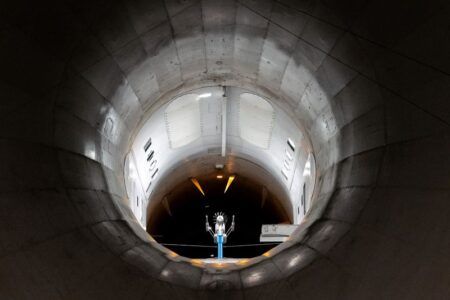The US AIr Force’s Hypervelocity Wind Tunnel 9 in White Oak, Maryland, is on the verge of delivering an unprecedented capability.
The engineering team at Tunnel 9 completed an initial shakeout of the Mach 18 system in April and are set to begin a full calibration on Mach 18 later this year. If successful, this would allow for testing at Mach Numbers never before realized in an Arnold Engineering Development Complex (AEDC) test facility.
“For years, important programs have asked for a validated capability in this Mach range to reduce risk in vehicle designs,” said Tunnel 9 Site Director Dan Marren. “With this accomplishment, the team has added something new to the fight.”
Early Research
Researchers have been working for decades to achieve a higher Mach capability, and the desire to attain such Mach Numbers dates back to the inception of Tunnel 9.
Tunnel 9, which became operational in 1976, was originally conceptualized to achieve Mach Numbers of 10, 15 and 20.
Initially, Tunnel 9 was only able to deploy Mach 10 and Mach 14 capabilities. It would be some time before the significant leaps in technology needed to eclipse Mach 14 would come around due to a lack of understanding of the physics required to operate at that level.
During the late 1980s and into the 1990s, the USA’s National Aerospace Plane Program was seeking data above Mach 14 and, believing the technology was ready, provided some funding to Tunnel 9 to develop Mach 18.
However, the nozzle design methodology and the diagnostics that would be used to examine the physics of the flow were immature. The flow quality of the nozzle was deemed poor, and the design was scrapped.
Around 30 years ago, Marren and current Tunnel 9 Technical Director John Lafferty were beginning their careers at what was then known as Naval Surface Warfare Center Tunnel 9. The young engineers worked with Dr. Wayland Griffith from North Carolina State University, who was a visiting summer professor at Tunnel 9. The trio researched a phenomenon called supercooling, which they believed could be used to relax the need to have the facility heater operate up to 5,000 degrees Fahrenheit to achieve higher Mach Numbers.
Marren, Lafferty and Griffith found that the supercooling method worked, though they did not yet have access to the advanced diagnostics needed to verify the flow physics. Although their tests were not completely conclusive, the trio published their conclusions anyway. This data would later become the foundation of the Mach 18 capability, as researchers at NASA read the report and began their own research into the supercooling phenomenon.
As NASA continued to study that process, those at Tunnel 9 moved on to missile defense projects and other sub-Mach 20 priorities.
In the mid-2000’s, higher Mach Number hypersonics once again became a priority. The Office of the Secretary of Defense, or OSD, turned to AEDC to push the boundaries of hypersonic test capabilities.
Advancements in technology and equipment
Fortunately for those at AEDC, computer-based modeling and simulation and diagnostic technologies had greatly advanced in the more than two decades since the capability was first sought, and many of those at Tunnel 9 who had worked the original request for the National Aerospace Program were still employed at the facility. A team was assembled and a program was designed.
Initial risk reduction efforts began in 2014 and focused on the development of three state-of-the-art efforts: a new material for the nozzle, new laser diagnostics to verify the understanding of the flow physics, and a new nozzle contour based on that understanding. This three-year effort leveraged two Small Business Innovation Research programs and investment funds from AEDC to successfully achieve its goals.
Following this risk reduction effort, Lafferty convinced OSD to construct the new capability for $6.5 million. With that, the team at Tunnel 9 set out in 2017 to achieve Mach 18 capability. Their goal was to accomplish this in three years.
Prior to Lafferty proposing the Mach 18 program to the OSD, Lafferty and Tunnel 9 Chief Facility Engineer Nick Fredrick had proposed a low-level technology effort, funded with an approximately US$200,000 fallout from the AEDC budget, to investigate and demonstrate the feasibility of all the technologies required for Mach 18. The project received around US$3 million in additional funding through the Small Business Innovation Research program. Half of this funding came from the SBIR Commercialization Readiness Program to investigate new throat materials, and the remaining US$1.5 million was to be used to develop new advanced laser-based diagnostics to probe non-intrusively into the flowfield.
“Early in the Mach 18 nozzle design process, we at Tunnel 9 quickly realized that the existing technologies used in our facility would be inadequate to develop a Mach 18 capability with the flow quality that we required,” Fredrick said. “The work with SBIR allowed us to bring the experts that would eventually work with us to achieve our goals. Their work was critical to the success of the Tunnel 9 Mach 18 capability.”
In the years since Marren and Lafferty had first worked with Griffith, what Marren had referred to as “three miracles of science” had occurred. First, materials technology had progressed significantly. To accomplish testing at higher Mach Numbers, the team at Tunnel 9 needed a high-temperature nozzle throat material four times stronger than anything that had previously existed. That material, developed as part of this program, is now available.
The second “miracle” was advancements in diagnostics. Available non-intrusive laser diagnostics had become fast enough and with sufficient signal to noise to verify the understanding of the flow during supercooling. Two efforts converged to provide this understanding. First, Jeff Balla, a researcher at NASA Langley, had completed the research started by Lafferty and Marren more than two decades prior using modern tools and diagnostics. Balla delivered that information to Tunnel 9 personnel that verified the flow density. Second, an SBIR with PlasmaTec was completed that allowed measurements of the flow velocity and temperature. The data from all three of these measurements verified the understanding of the flow physics including its required chemical makeup.
“The recent development of ultra-short pulse-width laser systems has made low-density velocity and temperature measurements possible,” said Michael Smith, Tunnel 9 advanced diagnostician and physicist. “These diagnostics provide the verification that the Mach 18 facility is truly providing the flow quality for which it was designed.”
The third miracle was the advancement of nozzle design tools. Working with Ken Tatum and Derik Daniel, AEDC counterparts at Arnold Air Force Base, and John Korte, a subject matter expert in high Mach nozzle design who had recently retired from NASA Langley and now works for Analytical Mechanics Associates, the Tunnel 9 team was able to include this new understanding of the flow physics into the design of a new high Mach Number wind tunnel nozzle contour for the first time.
“This promises to produce the best possible flow quality for any nozzle at these Mach Numbers,” Lafferty said.
Team’s efforts pay off
Those at Tunnel 9 scoped out the construction of the Mach 18 undertaking that began in 2017.
With the funding and the assistance Tunnel 9 engineers were receiving on nozzle design, the Mach 18 project looked feasible. The OSD pushed for completion and implementation of the capability as quickly as possible.
Eventually, Tunnel 9 would receive $6.5 million in additional funding from the Hypersonic Test Capability Improvement Project, an OSD investment program that aims to improve capabilities for hypersonic weapon systems development, to move the Mach 18 project forward.
The nozzle design and build, the successful incorporation of the new nozzle throat material, and the diagnostic demonstration all occurred within the three-year timeframe and were completed within budget and on-schedule.
The shakeout of the Tunnel 9 capability has occurred in phases. Around two years ago, diagnostic and supercooling checkouts were done by applying to the Tunnel 9 Mach 14 nozzle the pressure and temperature conditions similar to those of Mach 18.
A full checkout of the throat technologies using the Mach 14 nozzle occurred last year.
In April, Tunnel 9 took advantage of an opportunity to accelerate a portion of the Mach 18 calibration. Those at the facility are in the process of repairing one of the four compressor motors used to create a vacuum source and proper pressure ratio required to maintain fully operationally test capability.
While that motor is out for repair, the facility can still perform a subset of conditions. For example, the validation of Mach 18 design condition, the highest part of the simulation envelope for the Mach 18 test capability is possible without the fourth motor.
The Tunnel 9 team performed the initial calibration using the final Mach 18 hardware. To accomplish this, they aligned the facility to ready it for a test, validated the survival and performance of the new throat design, verified the thermodynamic quality of the test medium, and confirmed the facility flow is of a high quality for future acquisition customers.
“To date, there have been four test entries at Tunnel 9 to demonstrate the feasibility of the Mach 18 capability,” Fredrick said. “The first three of these tests were performed in the existing Mach 14 nozzle and were used to validate the assumptions that the flow would be condensation-free at the proposed Mach 18 freestream conditions and that the new nozzle throat material can survive and is shape-stable at both Mach 14 and Mach 18 nozzle supply conditions.
“The most recent test entry validated the new Mach 18 nozzle with the new nozzle throats at the design condition. This validation included measurements of the flow uniformity for comparison to computational fluid dynamics results, measurements of the nozzle freestream velocity and temperature, and measurements to detect condensation. Only one test remains – the calibration of the nozzle at all of the desired test conditions.”
The full calibration to bring Mach 18 to full operating capability is set to occur between September and December.
“Mach 18 is a long time coming and will fill a real gap,” Lafferty said. “However, I never thought we would have multiple test customers lined up to collect data even before we had finished the shakeout and calibration. It is satisfying to know it will be used once complete.”
This article was originally published on the USA’s Air Force Material Command website and can be read in irs original form here.





